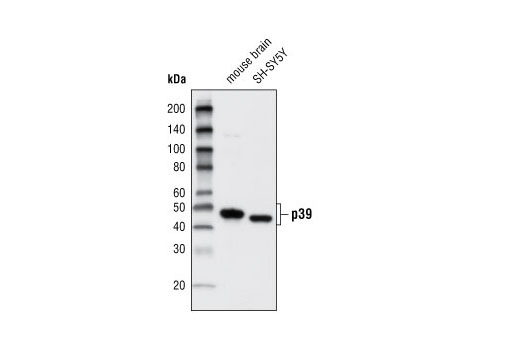WB
H M R
Endogenous
39-45
Rabbit
#Q13319
8941
Product Information
Product Usage Information
| Application | Dilution |
|---|---|
| Western Blotting | 1:1000 |
Storage
Specificity / Sensitivity
Species Reactivity:
Human, Mouse, Rat
Source / Purification
Polyclonal antibodies are produced by immunizing animals with a synthetic peptide surrounding Thr90 of human p39. Antibodies are purified by peptide affinity chromatography.
Background
Cyclin-dependent kinases (CDKs) are serine/threonine kinases that are activated by cyclins and govern eukaryotic cell cycle progression. While CDK5 shares high sequence homology with its family members, it is thought mainly to function in postmitotic neurons, regulating the cytoarchitecture of these cells. Analogous to cyclins, p35 and p39 associate with and activate CDK5 despite the lack of sequence homology. CDK5 is ubiquitously expressed, but high levels of kinase activity are detected primarily in the nervous system due to the narrow expression pattern of p35 and p39 in post-mitotic neurons. A large number of CDK5 substrates have been identified although no discrete substrates have been attributed as a function of p35 vs. p39. Amongst many, substrates of CDK5 include p35 and p39. p35 is rapidly degraded (T1/2 <20 min) by the ubiquitin-proteasome pathway (1). However, p35 stability increases as CDK5 kinase activity decreases, and this is likely a result of decreased phosphorylation of p35 at Thr138 by CDK5 (2). NGF activates Erk and EGR1, and induces p35 expression in PC12 cells (3). Proteolytic cleavage of p35 by calpain produces p25 upon neurotoxic insult, resulting in prolonged activation of CDK5 by p25. Accumulation of p25 is found in neurodegenerative diseases such as Alzheimer's disease and Amyotrophic Lateral Sclerosis (ALS) (4-5).
CDK5-null mice are perinatal lethal, whereas p35 or p39-null mice are viable. However, p35 and p39 double-null mutants display phenotypes identical to those of the CDK5-null mutant mice (6). Association of p39 but not p35 with CDK5 promotes Munc18-1 phosphorylation and Ca2+-dependent exocytosis (7). p39 binds to the actin cytoskeleton associated protein muskelin, and localizes to lamellipodia, fillopodia and growth cones of neurons (8,9).
- Dhavan, R. and Tsai, L.H. (2001) Nat. Rev. Mol. Cell Biol. 2, 749-759.
- Patrick, G.N. et al. (1998) J. Biol. Chem. 273, 24057-24064.
- Harada, T. et al. (2001) Nat. Cell Biol. 3, 453-459.
- Lee, M.S. et al. (2000) Nature 405, 360-364.
- Kusakawa, G. et al. (2000) J. Biol. Chem. 275, 17166-17172.
- Ko, J. et al. (2001) J. Neurosci. 21, 6758-6771.
- Lilja, L. et al. (2004) J Biol Chem 279, 29534-29541.
- Ledee, D.R. et al. (2005) J. Biol. Chem. 280, 21376-21383.
- Humbert, S. et al. (2000) J. Cell Sci. 113 ( Pt 6), 975-983.
Species Reactivity
Species reactivity is determined by testing in at least one approved application (e.g., western blot).
Western Blot Buffer
IMPORTANT: For western blots, incubate membrane with diluted primary antibody in 5% w/v BSA, 1X TBS, 0.1% Tween® 20 at 4°C with gentle shaking, overnight.
Applications Key
WB: Western Blotting
Cross-Reactivity Key
H: human M: mouse R: rat Hm: hamster Mk: monkey Vir: virus Mi: mink C: chicken Dm: D. melanogaster X: Xenopus Z: zebrafish B: bovine Dg: dog Pg: pig Sc: S. cerevisiae Ce: C. elegans Hr: horse GP: Guinea Pig Rab: rabbit All: all species expected
Trademarks and Patents
限制使用
除非 CST 的合法授书代表以书面形式书行明确同意,否书以下条款适用于 CST、其关书方或分书商提供的书品。 任何书充本条款或与本条款不同的客书条款和条件,除非书 CST 的合法授书代表以书面形式书独接受, 否书均被拒书,并且无效。
专品专有“专供研究使用”的专专或专似的专专声明, 且未专得美国食品和专品管理局或其他外国或国内专管机专专专任何用途的批准、准专或专可。客专不得将任何专品用于任何专断或治专目的, 或以任何不符合专专声明的方式使用专品。CST 专售或专可的专品提供专作专最专用专的客专,且专用于研专用途。将专品用于专断、专防或治专目的, 或专专售(专独或作专专成)或其他商专目的而专专专品,均需要 CST 的专独专可。客专:(a) 不得专独或与其他材料专合向任何第三方出售、专可、 出借、捐专或以其他方式专专或提供任何专品,或使用专品制造任何商专专品,(b) 不得复制、修改、逆向工程、反专专、 反专专专品或以其他方式专专专专专品的基专专专或技专,或使用专品开专任何与 CST 的专品或服专专争的专品或服专, (c) 不得更改或专除专品上的任何商专、商品名称、徽专、专利或版专声明或专专,(d) 只能根据 CST 的专品专售条款和任何适用文档使用专品, (e) 专遵守客专与专品一起使用的任何第三方专品或服专的任何专可、服专条款或专似专专
